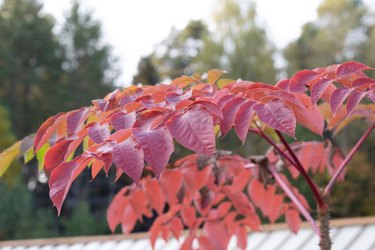
Aralia elata is a member of the carrot family and grows almost as fast. This east Asia import can grow at a rate of 2 feet in a single season, and it is also very showy since its flower clusters can be 2 feet wide. Topping out at about 20 feet, it can be viewed as a small tree or a large shrub.
It propagates so easily that it is considered invasive in some areas. You can propagate it by seeds, division, or root cuttings.
Video of the Day
Video of the Day
Meet the Aralia Elata
Aralia elata is more commonly called the angelica tree or the Japanese angelica. It is a large shrub or small tree that bears long clusters of pale yellow flowers that can grow to 18 inches long. They appear in late summer and are extremely showy. They develop small, round, dark purple fruit. Their foliage can be toxic to dogs.
The tree is deciduous and can grow to 20 feet tall and 10 feet wide. It usually grows with many trunks, and all are covered by a thorny bark. This makes the plant a popular choice for defensive hedging.
Caring for Aralia Elata
The angelica tree is a tolerant plant. It is drought-tolerant and can accept a wide range of soil types as long as the drainage is excellent. It tolerates dry soil and urban pollution. The tree does best in a sunny site with at least six hours of direct sun, but it will accept indirect light as well.
The angelica tree grows well in U.S. Department of Agriculture plant hardiness zones 4a to 9a. It is a fast-growing tree, and it can be used to create a quick hedge or to populate a burned-out area quickly when it is necessary.
Root Aralia Cuttings
The most efficient and recommended methods of propagating the angelica tree are seeds or division. The seeds grow so readily that the plant is classified as invasive in some areas. Division means digging up the plant, cutting the root ball into several divisions, and planting each in a separate place. It is also possible to use division to separate suckers growing near the tree and replant them as individual specimens.
The Japanese angelica can also be propagated from root cuttings. Take 3- to 5-inch root cuttings in December. Once you have taken as many cuttings as you want, place them in an upside-down position in sand. In late winter or early spring, pot them in well-drained soil, give them water and indirect light, and wait for them to sprout.